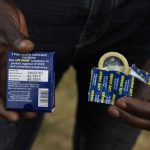World AIDS Day 2022: Latest facts and figures about number of people with AIDS
Reading Time: 3 minutes
 2054
2054
Page Contents
World AIDS Day
Today, the 1st of December, is World AIDS Day: an opportunity to draw attention to the ongoing fight against HIV. Here are the latest facts and figures about number of people infected and affected by AIDS.
Global HIV & AIDS statistics — Fact sheet
Global HIV statistics
- 38.4 million [33.9 million–43.8 million] people globally were living with HIV in 2021.
- 1.5 million [1.1 million–2.0 million] people became newly infected with HIV in 2021.
- 650 000 [510 000–860 000] people died from AIDS-related illnesses in 2021.
- 28.7 million people were accessing antiretroviral therapy in 2021.
- 84.2 million [64.0 million–113.0 million] people have become infected with HIV since the start of the epidemic.
- 40.1 million [33.6 million–48.6million] people have died from AIDS-related illnesses since the start of the epidemic.
People living with HIV
- In 2021, there were 38.4 million [33.9 million–43.8 million] people living with HIV.
- 36.7 million [32.3 million–41.9 million] adults (15 years or older).
- 1.7 million [1.3 million–2.1 million] children (0–14 years).
- 54% of all people living with HIV were women and girls.
- 85% [75– 97%] of all people living with HIV knew their HIV status in 2021.
- About 5.9 million people did not know that they were living with HIV in 2021.
People living with HIV accessing antiretroviral therapy
- At the end of December 2021, 28.7 million people were accessing antiretroviral therapy, up from 7.8 million in 2010.
- In 2021, 75% [66–85%] of all people living with HIV were accessing treatment.
- 76% [67–87%] of adults aged 15 years and older living with HIV had access to treatment, as did 52% [42–65%] of children aged 0–14 years.
- 80% [72–91%] of female adults aged 15 years and older had access to treatment; however, just 70% [61–82%] of male adults aged 15 years and older had access.
- 81% [63–97%] of pregnant women living with HIV had access to antiretroviral medicines to prevent transmission of HIV to their child in 2021.
New HIV infections
- New HIV infections have been reduced by 54% since the peak in 1996.
- In 2021, around 1.5 million [1.1 million–2.0 million] people were newly infected with HIV, compared to 3.2 million [2.4 million–4.3 million] people in 1996.
- Women and girls accounted for 49% of all new infections in 2021.
- Since 2010, new HIV infections have declined by 32%, from 2.2 million [1.7 million–2.9 million] to 1.5 million [1.1 million–2.0 million] in 2021.
- Since 2010, new HIV infections among children have declined by 52%, from 320 000 [220 000–480 000] in 2010 to 160 000 [110 000–230 000] in 2021.
AIDS-related deaths
- AIDS-related deaths have been reduced by 68% since the peak in 2004 and by 52% since 2010.
- In 2021, around 650 000 [510 000–860 000] people died from AIDS-related illnesses worldwide, compared to 2.0 million [1.6 million–2.7 million] people in 2004 and 1.4 million [1.1 million–1.8 million] people in 2010.
- AIDS-related mortality has declined by 57% among women and girls and by 47% among men and boys since 2010.
Key populations
- In 2021, key populations (sex workers and their clients, gay men and other men who have sex with men, people who inject drugs, transgender people) and their sexual partners accounted for 70% of HIV infections globally:
- 94% of new HIV infections outside of sub-Saharan Africa.
- 51% of new HIV infections in sub-Saharan Africa.
- The risk of acquiring HIV is:
- 35 times higher among people who inject drugs than adults who do not inject drugs.
- 30 times higher for female sex workers than adult women.
- 28 times higher among gay men and other men who have sex with men than adult men.
- 14 times higher for transgender women than adult women.
Women
- Every week, around 4900 young women aged 15–24 years become infected with HIV.
- In sub-Saharan Africa, six in seven new HIV infections among adolescents aged 15–19 years are among girls. Girls and young women aged 15–24 years are twice as likely to be living with HIV than young men.
- In sub-Saharan Africa, women and girls accounted for 63% of all new HIV infections in 2021
95–95–95
- In 2021, 85% [75–97%] of people living with HIV knew their HIV status.
- Among people who knew their status, 88% [78– >98%] were accessing treatment.
- And among people accessing treatment, 92% [81– >98%] were virally suppressed.
- Of all people living with HIV, 85% [75–97%] knew their status, 75% [66–85%] were accessing treatment and 68% [60–78%] were virally suppressed in 2021.
Investments
- At the end of 2021, US$ 21.4 billion (in constant 2019 United States dollars) was available for the AIDS response in low- and middle-income countries—around 60% was from domestic sources.
- UNAIDS estimates that US$ 29 billion (in constant 2019 United States dollars) will be required for the AIDS response in low- and middle-income countries, including countries formerly considered to be upper-income countries, in 2025 to get on track to end AIDS as a global public health threat.
- (Sourced from UNAIDS)
 2054
2054






